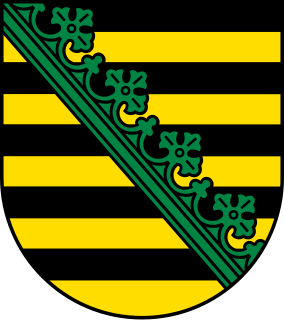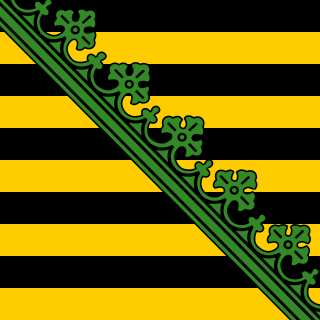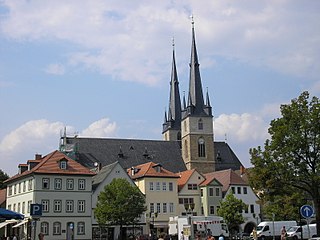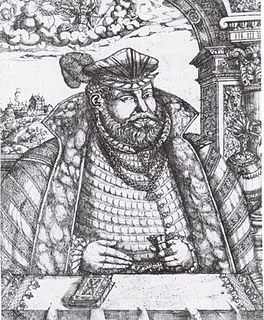History
The duchy was created by the Division of Erfurt in 1572 which implemented a decision of the Diet of Speyer in 1570 to separate Coburg and Eisenach from the Duchy of Saxe-Weimar and give them to John Casimir and John Ernest, the two sons of John Frederick II. However, because the two princes were still minors at the time, the country was at first ruled by Elector August of Saxony.
In 1586 the guardianship and regency ended, and John Casimir and John Ernest began to jointly to rule the duchy. John Ernest soon withdrew and returned to his hunting lodge in Marksuhl. In 1590 he formally renounced all of his participation in the government of the duchy for five years. After the end of this period, the two brothers agreed to split the country. John Casimir kept Saxe-Coburg, while John Ernest received Saxe-Eisenach.
When John Casimir died childless in 1633, John Ernest inherited his possessions and Coburg and Eisenach were combined again for a short period. When John Ernest died childless as well in 1638, the line of the Dukes of Saxe-Coburg-Eisenach ended and the country was divided between Saxe-Weimar and Saxe-Altenburg, the other two Ernestine duchies existing at that time.
Saxe-Coburg and Saxe-Eisenach would not again belong to a common state, until all Ernestine duchies merged to form Thuringia in 1920.

Saxe-Coburg and Gotha, or Saxe-Coburg-Gotha, was an Ernestine, Thuringian duchy ruled by a branch of the House of Wettin, consisting of territories in the present-day states of Thuringia and Bavaria in Germany. It lasted from 1826 to 1918. In November 1918, Charles Edward, Duke of Saxe-Coburg and Gotha, was forced to abdicate. In 1920, the northern part of the duchy was merged with six other Thuringian free states to form the state of Thuringia: Saxe-Weimar-Eisenach, Saxe-Altenburg and Saxe-Meiningen, Schwarzburg-Rudolstadt and Schwarzburg-Sondershausen, as well as the People's State of Reuss. The southern part of the duchy, as southernmost of the Thuringian states, was the only one which, after a referendum, became part of Bavaria.

The House of Wettin is a dynasty of German counts, dukes, prince-electors and kings that once ruled territories in the present-day German states of Saxony, Saxony-Anhalt and Thuringia. The dynasty is one of the oldest in Europe, and its origins can be traced back to the town of Wettin, Saxony-Anhalt. The Wettins gradually rose to power within the Holy Roman Empire. Members of the family became the rulers of several medieval states, starting with the Saxon Eastern March in 1030. Other states they gained were Meissen in 1089, Thuringia in 1263, and Saxony in 1423. These areas cover large parts of Central Germany as a cultural area of Germany.

Saxe-Altenburg was one of the Saxon duchies held by the Ernestine branch of the House of Wettin in present-day Thuringia. It was one of the smallest of the German states with an area of 1323 square kilometers and a population of 207,000 (1905) of whom about one fifth resided in the capital, Altenburg. The territory of the duchy consisted of two non-contiguous territories separated by land belonging to the Principality of Reuss. Its economy was based on agriculture, forestry, and small industry. The state had a constitutional monarchical form of government with a parliament composed of thirty members chosen by male taxpayers over 25 years of age.

Saxe-Meiningen was one of the Saxon duchies held by the Ernestine line of the Wettin dynasty, located in the southwest of the present-day German state of Thuringia.

Saxe-Weimar-Eisenach was created as a duchy in 1809 by the merger of the Ernestine duchies of Saxe-Weimar and Saxe-Eisenach, which had been in personal union since 1741. It was raised to a grand duchy in 1815 by resolution of the Vienna Congress. In 1903, it officially changed its name to the Grand Duchy of Saxony, but this name was rarely used. The Grand Duchy came to an end in the German Revolution of 1918–19 with the other monarchies of the German Empire. It was succeeded by the Free State of Saxe-Weimar-Eisenach, which was merged into the new state of Thuringia two years later.

Saxe-Coburg was a duchy held by the Ernestine branch of the Wettin dynasty in today's Bavaria, Germany.

Saxe-Gotha was one of the Saxon duchies held by the Ernestine branch of the Wettin dynasty in the former Landgraviate of Thuringia. The ducal residence was erected at Gotha.

Saalfeld is a town in Germany, capital of the Saalfeld-Rudolstadt district of Thuringia. It is best known internationally as the ancestral seat of the Saxe-Coburg and Gotha branch of the Saxon House of Wettin, which was renamed the House of Windsor during their British reign in 1917.

Saxe-Hildburghausen was an Ernestine duchy in the southern side of the present State of Thuringia in Germany. It existed from 1680 to 1826 but its name and borders are currently used by the District of Hildburghausen.

Saxe-Weimar was one of the Saxon duchies held by the Ernestine branch of the Wettin dynasty in present-day Thuringia. The chief town and capital was Weimar. The Weimar branch was the most genealogically senior extant branch of the House of Wettin.

Saxe-Eisenach was an Ernestine duchy ruled by the Saxon House of Wettin. The state intermittently existed at three different times in the Thuringian region of the Holy Roman Empire. The chief town and capital of all three duchies was Eisenach.

The Ernestine duchies, also known as the Saxon duchies, were a changing number of small states that were largely located in the present-day German state of Thuringia and governed by dukes of the Ernestine line of the House of Wettin.

Saxe-Gotha-Altenburg was a duchy ruled by the Ernestine branch of the House of Wettin in today's Thuringia, Germany. The extinction of the line in 1825 led to a major re-organisation of the Thuringian states.

Johann Wilhelm was a duke of Saxe-Weimar.

John Frederick II of Saxony, was Duke of Saxony (1554–1566).

John Casimir of Saxe-Coburg was the Duke of Saxe-Coburg. He was the descendant of the Ernestine branch of the House of Wettin. Under his rule, the residence town of Coburg prospered with many Renaissance buildings being erected that still remain today.

Johann Ernst of Saxe-Eisenach, was a duke of Saxe-Eisenach and later of Saxe-Coburg.

The coat of arms of the present-day German free state of Saxony shows a tenfold horizontally-partitioned field of black (sable) and gold/yellow (or) stripes, charged with a green (vert) crancelin running from the viewer's top-left to bottom-right. Although the crancelin is sometimes shown bent (embowed) like a crown, this is due to artistic license. The coat of arms is also displayed on the state flag of Saxony.

Elisabeth of the Palatinate was the second wife of Duke John Frederick II of Saxony.
The “Grumbach Feud”, in 1567, was a rather bizarre episode in the history of the Ernestine side of the House of Wettin, which led to life imprisonment for Elector John Frederick II “the Middle”, the Duke of Saxe-Coburg-Eisenach.


















